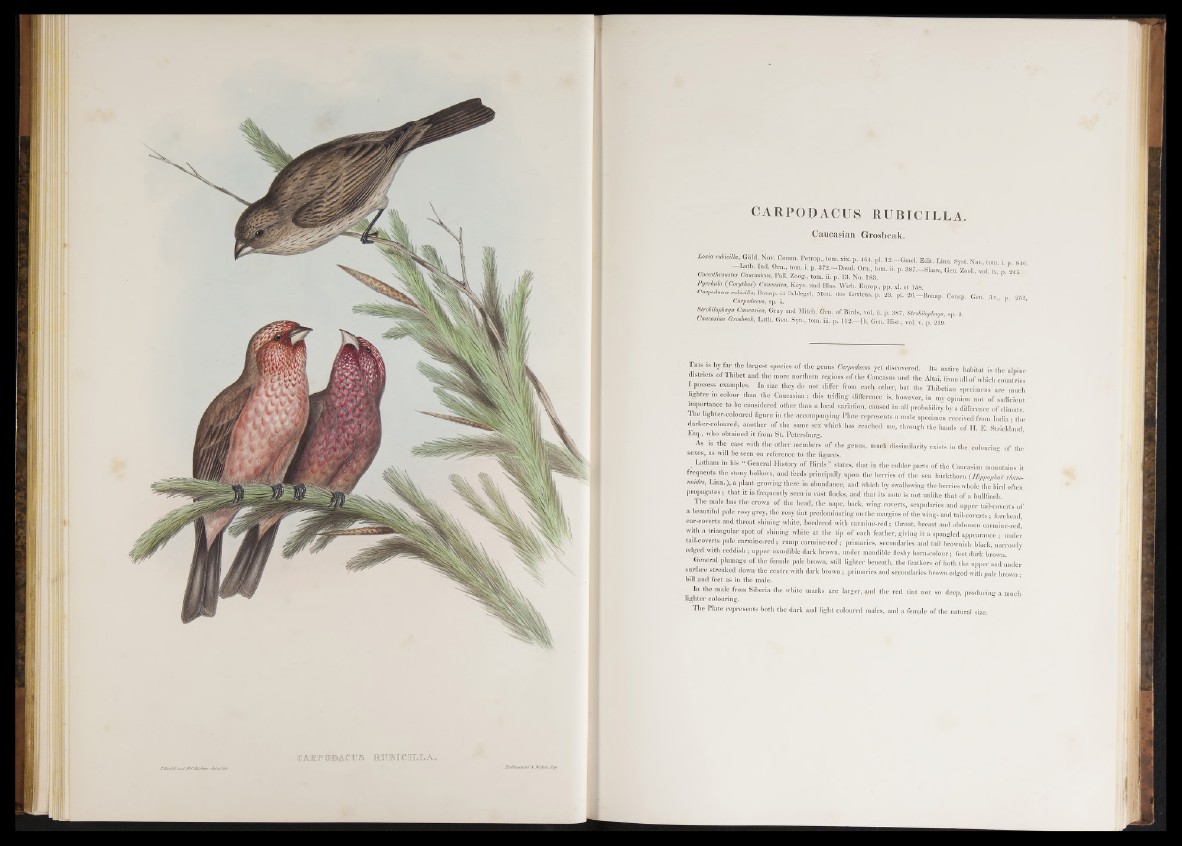
CAKPOBACTfS S U B IC I I X 4 , jrOmMsaui/FCJhabtr JtZtMA.
CARPODACUS RUBICILLA.
Caucasian Grosbeak.
Lm ia ruU citla Güld N o t . Comm. Petrop., tom. xix. p. 464. pi. 1 2 ,-G m e l. Edit. Linn. Syst. N a t, tom. i. p . 846
■„ , , i„ , ■’ tom- B 372-—D a u i- 0 m - tom. ii. pi 387.— Shaw, Gen. Zool.. vol. ix p 246
Coccothraustes Caucasicus, Pall. Zoog., tom. ii. p. 13. No. 183. V ' 1 '
P yrrh d a (Gorythuf) Caucasica, Keys, un d Blas. Wirb. Europ., pp. xl. « t i f |
Carpodacus rubicilla, Bonap. e t Schlegel, Mom des Loxieos. p. 23. pi. 2 6 ,-B o n a p . ConSp. Gen. Av p 262
Carpodacus, sp. 5. > i • >
Strobilophaga Caucasica, Gray and Mitch. Gen. of B irds, vol. ii. p. 387, Strolilophaoa, sp. 2.
Caucasian Grosbeak, Lath. Gen. Syn., tom. iii. p. 112.—Ib. Gen. Hist., vol. v. p. 219.
Tms is by far the largest species of the genus Carpodacus y e t discovered. Its natiye habitat is the alpiue
districts of Thibet and the more northern regions of the Caucasus and the Altai, from all of which countries
I possess examples, In size they do not differ from eacfc other, but the Thibetian specimens are much
lighter in colour than the Caucasian: this trifling difference is, however, in my opinion not of sufficient
importance to be considered other than a local variation,,«Seed in all probability by a difference of climate
The lighter-coloured figure in the accompanying Plate represents a male specimen received from India • the
darker-coloured, another o f the same sex which has reached me, through the hands of H. E. Strickland
Esq., who obtained it from St. Petersburg.
As is the case with the other members o f the genus, much dissimilarity exists in the colouring of the
sexes, as will be seen on reference to the figures.
r Latham in his “ General History of B ird s” states, that in the colder parts o f the Caucasian mountains it
frequents the stony hollows, and feeds principally upon the berries of the sea buckthorn (Hippophae rham-
noides, L in n .), a plant growing there in abundance, and which by swallowing the berries whole the bird often
propagates; that it is frequently seen in vast flocks, and that its note is not unlike that of a bullfinch.
The male has the crown of the head, the nape, back, wing-coverts, scapularies and upper tail-coverts of
a beautiful pale rosy grey, the rosy tint predominating on the margins of the wing- and tail-coverts; forehead,
ear-coverts and throat shining white, bordered with carmine-red; throat, breast and abdomen carmine-red,
with a triangular spot of shining white a t the tip of each feather, giving it a spangled appearance ; under
tail-coverts pale carmine-red ; rump carmine-red; primaries, secondaries and tail brownish black, narrowly
edged with reddish; upper mandible dark brown, under mandible fleshy horn-colour; feet dark brown.
General plumage o f the female pale brown, still lighter beneath, the feathers of both the upper and under
surface streaked down the centre with dark brown; primaries and secondaries brown edged with pale brown •
bill and feet as in the male.
In the male from Siberia the white marks are larger, and the red tint not so deep, producing a much
lighter colouring.
The Plate represents both the dark and light coloured males, and a female of the natural size.